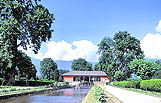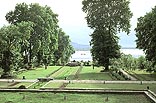|
MASTERPIECES WERE PRODUCED
ON THE FRONTIER OF THE ISLAMIC WORLD
The most famous pieces of Islamic architecture in the world would be the Alhambra in Granada, Spain in the west, and the Taj Mahal in Agra, India in the east. Even if one doesn't know of the Great Mosques in Isfahan and Damascus, he would know the names of these two and must have seen their pictures. BR>
Nevertheless neither Spain no India is the center or birthplace of the Islamic world, but rather marginal land of the extreme west and east. Islamic gardens also developed greatly in Spain and India rather than other areas.
The Alhambra's patios and nearby Generalife Garden in Spain, Kashmir's "Shalamar Bagh" and "Nishat Bagh" in India, those Islamic 'baghs' (gardens) arranged with garden paths, water streams, garden pavilions, and fountains in a geometric form of landscape are full of peace and comfort, that is to say 'earthly paradise.'
Then, why were the masterpieces of Islamic architecture and gardening born in such marginal lands of the Islamic world? Islamic dynasty in Spain was a transplanted branch
of Umayyad dynasty in Damascus, and Mughal dynasty in India was inaugurated by a cultured emperor Babur coming from Kabul in the Persian sphere.
We therefore reach current Syria to visite a source of the Spanish Islamic gardens, and reach current Iran for Mughal gardens, but why then are Spanish or Indian gardens more famous than those from the Middle East?
 
Nishat Gardens in Srinagar
GEOMETRICALLY DESIGNED GARDENS
IN THE MIDDLE EAST
The origin of Islamic gardens goes back most likely to the Middle East, particularly to Persia. In an arid desert area, Nature does not work as a guardian of humans, but as an antagonistic factor; intense heat, sandstorms, sirocco, burning sun, and so on. In order to protect oneself from such a harsh nature and to get a comfortable environment, one has to provide a 'sanctuary' insulated from external nature.
Thus gardens with ample water and cool arbor enclosed by walls or buildings evolved in this region, being called 'pairidaêza' in old Persian. This tradition, that had come into existence before Christianity, was succeeded by Islam, so it might have been better to have referred to this form as 'Middle Eastern Garden.'
The Prophet Muhammad, written as Mahomet in the past, reiterated heavenly Paradise promised to pious believers in the "Koran." It was modeled after this Middle Eastern Garden and the word 'pairidaêza' was brought, via 'paradeisos' in Greece, to Europe what is refered to as 'Paradise.'
Since there are naturally few plants in the desert, water plays the leading role in gardens. If there is a river nearby, one makes a conduit to supply water to a garden. If not, one might bring water all the way from a distant mountain, constructing underground aqueducts represented by the Iranian 'qanat.' One irrigates land and breeds trees and flowers with this water. Even if those plants might look impoverished from a Japanese or European view, 'bagh' (garden) with water and shade protected by a surrounding wall from the outside world could surely be paradise for people of the desert.
The most efficient and economic method to irrigate a garden is a regular disposition of watercourses in a grid pattern. This idea generated the 'Chahar Bagh' form that represents Islamic gardens. The meaning of it is 'four gardens' or 'quadripartite garden,' in which crossed water channels separate a square garden into four quarters symmetrically, so it is also called 'four quartered garden.'
 Four Quarter Garden (Chahar Bagh)
Four Quarter Garden (Chahar Bagh)
On the other hand, as idol worship is strictly prohibited in Islam, the art of sculpture and wall painting depicting creatures has not developed and buildings have been embellished with geometrical or foliage designs, that is to say 'arabesque.' Affected by this, garden design totally composed of geometric pattern from the whole to the details has become the main feature of Islamic gardens.
HARSH NATURE GENERATED STRONG
YEARNING FOR CELESTIAL PARADISE
However, it is needless to say that gardens being abundant in water and green can be nearer to heavenly paradise than those simply devised of geometric patterns with an enclosing wall. Gardens where numbers of fountains splash along water channels, verdurous trees grow thick making shade underneath, and a riot of flowers bloom colorfully; deep yearning toward such heavenly paradise has increased all the more because a natural environment in the Middle East is so severe.
Andalusia in Spain, where a branch of Umayyad came to settle themselves in elusion of the Abbasid's coup, is far more fertile, with ample water and green, than the Middle East, therefore they could make more comfortable gardens combining
the idea of the Middle East Garden and the nature of Andalusia.
As for India, Babur, who came from Kabul and established the Mughal dynasty, brought geometric garden design from the Middle East. As his successors' reign became stable, they went to Kashmir in the Himalayas every summer, escaping the intense heat in Delhi during. Since the weather is just like that of Japan's Hokkaido, the cool land around Lake Dal of limpid water surrounded by snow capped mountains was just an earthly paradise for them. They created many masterpieces of geometrical gardens full of verdure and spray of fountrains, setting up water channels supplying water from mountain slopes facing Lake Dal.
In view of the situation, those gardens in Andalusia and Kashmir cannot be referred to as Middle Eastern Garden. Since it was an evolution in garden style as a result of the expansion of the ruling area of Islam, there is no other choice other than referring to them as 'Islamic gardens.'
 
Patios of Basir House and Wakil House in Aleppo
As for the central area of the Islamic world, in addition to ample development of Persian gardens, courtyards of town houses in Syria and Egypt should not be omitted. For example, although townscape of endless range of ocher colored walls along narrow streets in Aleppo in Syria is quite monotonous, once inside those houses one can find comfortable courtyards equipped with plants, square ponds, and fountains, and a harmonious combination of house and garden different from Japanese way.
Isolated from the outside, the scenery of people bringing tea in a half-exterior space with round columns or under an 'iwan' of courtyard with the sound of a water fountain is quite peaceful and filled with serenity.
|